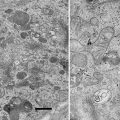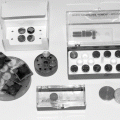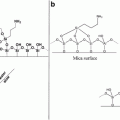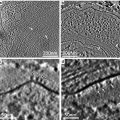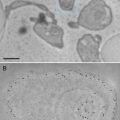(1)
IMAGE Center, Southern Illinois University, Carbondale, IL, USA
Abstract
In this chapter, we discuss conventional methods for handling cells grown suspended in liquid culture and on solid substrates. Protocols are given on how to prepare cultures for transmission electron microscopy, including the most commonly used buffers, fixatives, enrobement media, and embedding resins. These methods are suitable for a wide variety of organisms, ranging from prokaryotic bacteria to mammalian cells.
Key words
Cultured cellsTransmission electron microscopy proceduresBacteriaEukaryotic cells1 Introduction
A wide variety of cells, ranging from prokaryotic bacteria to mammalian cells, may be grown in culture. Depending on how the cells were cultured (suspended in a liquid medium or on a substrate such as agar or plastic) will determine how they are prepared for examination in the transmission electron microscope (TEM). Although details will vary, the basic steps are the same: fixation in buffered aldehyde, post-fixation in osmium tetroxide, dehydration in ethanol, embedding in a resin, ultramicrotomy, staining, and viewing in the TEM [1–4].
The first step involves selection of the primary fixative and buffer. An aldehyde fixative, usually glutaraldehyde, perhaps augmented with formaldehyde, is generally used as the primary fixative. Aldehydes penetrate cultured cells rapidly, cross-link proteins, and halt the dynamics of the living cell. Although many enzymes will remain active and immunological reactivity may be preserved after aldehyde treatment, motility and other processes will be stopped and the cell is considered fixed or dead. The aldehydes preserve mainly proteins and other macromolecules associated with proteins, such as lipoproteins and histoproteins associated with DNA. Glycogen may be preserved but the majority of carbohydrates will be extracted during the processing of the cells.
In order to enhance contrast of biological macromolecules viewed in the TEM, cells are post-fixed or treated with a secondary fixative such as osmium tetroxide. Although osmium tetroxide penetrates cells much slower than aldehyde fixatives, osmium tetroxide is a strong oxidizer that reacts vigorously with the double bonds of unsaturated lipids. Osmium solutions also react slowly with proteins, including the histoproteins, hence helping to preserve associated DNA. Carbohydrates are not preserved. After the oxidative reaction, the heavy metal osmium is reduced onto the macromolecules, thereby increasing their density and increasing contrast of the sectioned material when viewed in the TEM. Enzymatic activity and most immunological reactivity are destroyed. Because the cells are considerably hardened after the reaction, they are brittle and easily damaged by rough treatment during pipetting or centrifugation.
Several different buffers may be used to protect the cells during fixation. Traditionally, researchers have used buffers such as phosphate, cacodylate, and organic buffers such as PIPES (1,4 piperazine bis[2-ethanosulfonic acid]) [5]. Buffers are not entirely innocuous, however, and some fine detail may be altered. For example, high concentrations of phosphates may damage mitochondria; consequently, one should keep the buffer concentration as low as possible while still maintaining the pH within the desired range. Phosphate and cacodylate buffers predominate in electron microscopy but the organic buffers should be strongly considered since they are nontoxic and have less detrimental effects on fine structure. Organelles such as microfilaments and microtubules are better preserved and the increase in the overall density of the cell suggests that extraction is minimized with organic buffers [6].
After fixation with aldehyde and osmium tetroxide, specimens are dehydrated, usually in ethanol, by gradually replacing the water with an increasing concentration of ethanol. After the cells reach 100 % ethanol, they are infiltrated with a liquid plastic monomer, most commonly an epoxy resin. The epoxy is polymerized, resulting in a chemically preserved cell completely filled and surrounded by a hard plastic. Using an ultramicrotome, ultrathin sections of the plastic-embedded cells are cut and stained for contrast and examination in the TEM as described in other chapters in this book.
2 Materials
2.1 Equipment and Supplies
1.
250 ml beakers (two needed).
2.
Graduated cylinders (100 ml, 10 ml).
3.
Top loading balance for measuring buffer salts and resin components.
4.
Calibrated pH meter.
5.
Hot plate with magnetic stirrer and stirring bar.
6.
Glass pipettes (5 ml, 1 ml) and rubber bulb.
7.
Hot water bath adjusted to 40 or 60 °C, if agarose or agar enrobement is used.
8.
Glass Erlenmeyer flask, 100 ml.
9.
Wide-mouthed glass bottle with tight lid for preparing osmium tetroxide solution.
10.
Disposable polypropylene tubes (50 ml, 10 ml).
11.
Glass stirring rods, magnetic stir bars.
12.
Conventional centrifuge or, preferably, high-speed micro-centrifuge.
13.
Centrifuge tubes (conical, 10 ml) or micro-centrifuge tubes.
14.
Culture vessels (Petri dishes, plastic flasks, culture tubes).
15.
Dissecting needle, wooden applicator sticks.
16.
Polypropylene embedding capsules and holder.
17.
Oven adjusted to 60 °C.
2.2 Buffers
Although Sorenson’s phosphate and sodium arsenate or cacodylate buffers are more commonly used, PIPES buffer is nontoxic and easier to prepare. The buffers are used at a final, working dilution of 0.1 M.
1.
PIPES buffer: 0.2 M PIPES, pH adjusted with 1 N NaOH
PIPES buffer is prepared using 1,4 piperazine bis(2-ethanosulfonic acid), with a formula weight of 302.4 g/mol. To prepare a 0.2 M stock solution, dissolve 6.1 g of PIPES in 100 ml distilled water. Adjust the 100 ml PIPES solution to the desired pH using N NaOH (4.0 g/100 ml) as shown in Table 1 (see Note 1).
Table 1
Preparation of PIPES, 0.2 M buffer
pH | 6.4 | 6.6 | 6.8 | 7.0 | 7.2 | 7.4 | 7.6 |
N NaOH (ml) | 5.0 | 7.5 | 10.0 | 12.2 | 14.4 | 16.2 | 18.2 |
2.
Sorenson’s phosphate buffer: 0.2 M NaH 2 PO 4 and 0.2 M Na 2 HPO 4 combined in the appropriate amounts to obtain the desired pH
Sorenson’s phosphate buffer consists of two parts: 0.2 M monobasic sodium phosphate, NaH2PO4, and 0.2 M dibasic sodium phosphate, Na2HPO4. The weight of each component will vary depending on the waters of hydration. The pH is adjusted by mixing the two components as shown in Table 2.
Table 2
Preparation of Sorenson’s 0.2 M phosphate buffer
pH | A (ml) | B (ml) | pH | A (ml) | B (ml) |
|---|---|---|---|---|---|
6.0 | 87.7 | 12.3 | 7.0 | 39.0 | 61.0 |
6.2 | 81.5 | 18.5 | 7.2 | 28.0 | 72.0 |
6.4 | 73.5 | 26.5 | 7.4 | 19.0 | 81.0 |
6.6 | 62.5 | 37.5 | 7.6 | 13.0 | 87.0 |
6.8 | 51.0 | 49.0 | 7.8 | 8.5 | 91.5 |
3.
Cacodylate buffer: 0.2 M (CH 3 ) 2 AsO 2 Na (H 2 O is irrelevant if molarity is given) adjusted to the proper pH using 0.2 N HCl
Cacodylate buffer consists of a 0.2 M stock solution of sodium cacodylate in distilled water (4.28 g/100 ml) and the pH is adjusted by adding the appropriate volume of 0.2 M HCl (1.7 ml concentrated HCl/100 ml distilled water) to the 100 ml stock as shown in Table 3
Table 3
Preparation of cacodylate, 0.2 M buffer
pH | 6.0 | 6.2 | 6.4 | 6.6 | 6.8 | 7.0 | 7.2 | 7.4 |
0.2 M HCl (ml) | 59.2 | 47.6 | 36.6 | 26.6 | 18.6 | 12.6 | 8.4 | 5.5 |
(Caution: contains arsenic, poisonous, carcinogenic, absorbed through the skin, wear gloves).
2.3 Miscellaneous Reagents
1.
Loose specimens may be enrobed in a liquified agar solution. This is prepared by boiling 4 g agar in 100 ml distilled water or buffer until the agar is completely dissolved and the solution is no longer turbid. Once dissolved, store in a 60 °C oven in a capped container until needed. It will be useable for several days. Preferably, 4 % agarose should be used to enrobe the cells since it will dissolve in water or buffer at 45 °C. This much lower temperature will have fewer damaging effects on cells.
2.
Specimens can also be enrobed in a solution of 10 % gelatin. This is freshly prepared by dissolving plain gelatin (purchased at any food store) in boiling water or buffer. This may be stored at room temperature until needed. Since gelatin solutions are used at room temperature, they are less likely to damage cells.
3.
1.0 M CaCl2 (1.1 g/10 ml distilled water).
4.
0.2 M HCl (1.7 ml concentrated HCl/100 ml distilled water).
2.4 Fixatives (Use Electron Microscopy or Analytical Grade Reagents)
(Caution: poisonous, irritants, work in a fume good, wear gloves)
1.
Electron microscopy grade glutaraldehyde, 25 %, in sealed ampoules
Glutaraldehyde fixatives are easily prepared from 25 % solutions of electron microscopy grade glutaraldehyde in sealed glass ampoules by making a 1:10 dilution in the buffer of choice.
50 ml | 0.2 M Buffer stock solution at proper pH |
10 ml | 25 % Glutaraldehyde (electron microscopy grade) |
2 ml | 0.1 M CaCl2 (Important: do not use CaCl2 with phosphate buffer as a precipitate will form) |
40 ml | Distilled water |
2.




Glutaraldehyde/formaldehyde fixative
Glutaraldehyde/formaldehyde mixtures are often used with hard-to-fix cells or in specimens where a fixation protocol is not available. Formaldehyde fixatives are used in combination with glutaraldehyde since formaldehyde alone does not adequately preserve ultrastructural detail. A typical fixative consists of 4 % formaldehyde/2.5 % glutaraldehyde in the buffer of choice. Formaldehyde fixatives should be freshly prepared by depolymerizing paraformaldehyde powder using N NaOH (see Note 2).
(Caution: irritating fumes produced, use a fume hood).
Formaldehyde stock solution: Prepare an 8 % aqueous stock solution of formaldehyde by placing 50 ml of distilled water in a 100 ml flask with a stirring bar. Add 4.0 g of electron microscopy grade paraformaldehyde powder and stir the mixture while slowly raising the temperature up to 60 °C. Most of the powder will depolymerize but it is usually necessary to add several drops of N NaOH. After stirring for several minutes, the solution should be clear.
Glutaraldehyde-/formaldehyde-buffered fixative:
40 ml | 0.2 M Buffer stock solution at proper pH |
10 ml | 25 % Glutaraldehyde (electron microscopy grade) |
2 ml | 0.1 M CaCl2 (Important: do not use CaCl2 with phosphate buffer as a precipitate will form) |
50 ml | 8 % Aqueous formaldehyde stock solution |
After mixing the buffer and glutaraldehyde solutions on a magnetic stirrer, the formaldehyde solution is slowly added to the stirring solution until a clear solution is obtained. Finally, the CaCl2 is added, dropwise with stirring, to avoid formation of a precipitate.
Stay updated, free articles. Join our Telegram channel

Full access? Get Clinical Tree



